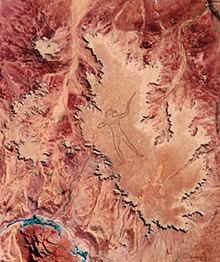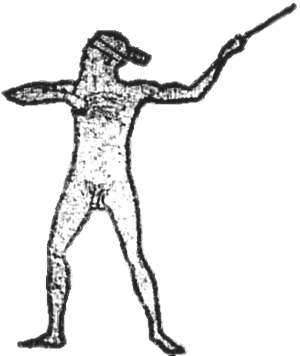
Artwork
The Marree Man geoglyph depicts a man holding either a throwing stick once used to disperse small flocks of birds, or a boomerang (but see Plaque section below).
The lines of the figure were 20–30 cm deep at the time of discovery and up to 35 metres wide.
Selecting a suitable site would have required aerial photography or satellite imagery. Using a computer, the figure could have been superimposed over the photograph and adjusted to fit the geography with the corresponding latitude and longitude coordinates mapped out. Some surveying skills would have been needed to plot the outline, and then with the aid of a hand-held global positioning system stakes could have been placed every hundred metres or so.[2]
The image is gradually eroding through natural processes, but because the climate is extremely dry and barren in the region, the image is still visible. While there is a layer of white chalk material slightly below the red soil, the figure was not defined to this depth. This raises the question why the creators did not dig a little deeper to make the image both more visible and more permanent.
[edit]Discovery

Trec Smith, a charter pilot flying between Marree and Coober Pedy in the remote north of South Australia spotted the figure from the air on June 26, 1998. The discovery of the geoglyph fascinated Australians due to its size and the mystery surrounding how it came to be there. At the time of the discovery there was only one track entering and one track exiting the site and no footprints or tire marks were discernible.
Shane Anderson from the William Creek Hotel, located 200 km north-west of the town of Marree claimed the hotel received an anonymous fax describing the location of the artwork, but they ignored it, dismissing the fax as a joke.
[edit]Anonymous press releases
Several anonymous press releases which appeared following the discovery led to the suggestion that the Marree Man was created by people from the United States. The releases quoted measurements in miles, yards and inches, instead of the metric system usually used in Australia. This would be unusual for an Australian press release, but since the metric system was only introduced in Australia in the 1970s, older Australians still often quote imperial measurements. The releases also said "your State of SA", "Queensland Barrier Reef" and mentioned Aborigines "from the local reservations". "Reservations" is a term more commonly associated with the North American Indians. The press releases also mentioned the Great Serpent in Ohio, which is not well known outside the US. But it has been conjectured that these features of the press releases may have been red herrings, inserted to provide the illusion of American authorship.[citation needed]
When the site was discovered, several items were found in a small pit[citation needed]: what appeared to be a satellite photo of the figure, a jar containing a small flag of the US, and a note which referred to the Branch Davidians, a religious group infamous for being attacked in the Waco raid in 1993. These were the only man-made items found at the site when it was discovered.
Artist Christopher Headley says that he sent two letters, one to Colonel Tom Meade, the head of the former US-Australian Joint Defense Facility Nurrungar, to ask about the possibility of making a permanent commemoration of the American presence in Australia. This could have inspired the idea of creating a geoglyph among locals.
[edit]Plaque
In January 1999, officials were told about a plaque buried 5 metres south of the nose of the figure, by way of a fax which was received via a hotel in Oxford, England.[citation needed] The fax also said that the plaque was intended to have been dug up by a "prominent US media figure" shortly before the Sydney 2000 Olympics.[citation needed] Similar clues were said to be buried near the Cerne Abbas giant near Dorset and theLong Man of Wilmington, Sussex, in England.[citation needed] The plaque has a 3 cm long by 2 cm wide American flag and an imprint of the Olympic rings. It reads:
In honour of the land they once knew. His attainments in these pursuits are extraordinary; a constant source of wonderment and admiration.[3]
The quote on the plaque buried at the figure comes from a book, "The Red Centre", by H.H. Finlayson, in a section describing the hunting of wallabies with throwing sticks and with photographs of hunters withoutloin cloths and with other details like the "Marree Man" [1]. In the book it can be deduced that the subject is a hunter from the Pitjantjatjara tribe.[4][citation needed]
[edit]Possible creators
- Bardius Goldberg, a Northern Territory artist who lived at Alice Springs, who a close friend says was given $10,000 at the time of the Marree Man's discovery.[5]
[edit]Mixed reaction
Much of the public and media reaction to the discovery of the figure was positive. The Advertiser, the State's only daily newspaper, called for the figure to be made permanent by excavating the outline down to the white chalk layer. But the site was closed shortly after discovery when some members of the Dieri tribe, whose lands lie east of Marree, complained of harm and exploitation of the Dreamtime.[6] It was called "environmental vandalism" by the Environment minister, Dorothy Kotz, and "graffiti" by the South Australian chief of Aboriginal affairs. While the site has been closed by the South Australian government, joy flights are still allowed over the site, which falls under Federal Government jurisdiction.
[edit]Authenticity of the figure
While the figure is shown nude, if the picture were copied from a 19th-century photograph it has been said that it may have had a loin cloth.[citation needed] There was also initially some question as to whether the figure is holding a throwing stick or a boomerang, but these issues seem to have been resolved following discovery of the plaque and the origin of the plaque quote and likely source photographs of similar nude hunters. The hand which is not throwing has the correct posture in the normal Aboriginal technique for throwing.[4] The initiation scars placed on the chest have also been said to have been placed perfectly. The figure appears to be an amalgam of the body of a man photographed in the distinctive throwing stance and the head of another man wearing a headband and chignon.


Very interesting
ReplyDelete